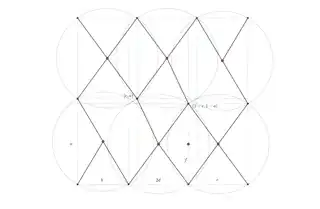Given a unit square and $n$ identical circles/discs, what is the smallest radius $r_n$ for which the circles can fully cover the square?
For $n=4$, the proven minimal solution is $r_4 = 1/(2\sqrt2) \approx 0.35355$
For $n=5$, the proven minimal solution is $r_5 \approx 0.32616$
For $n>5$, well, read on.
The context behind this is actually pretty thick, and includes:
- Last week's Riddler Classic
- This 2000 paper discussing this covering up to $n=30$, which has been linked in other questions
- My solution in Geogebra to the $5$-circle case
 |
 |
|---|---|
| Fig 1: $5$-Circle solution with analytic solution (OC) | Fig 2: $6$-Circle solution from Nurmelas & Ostergard, with labels |
The $5$-circle result has an analytical solution--though not one that yields a value except via numerical methods--via the following system of polynomials:
$$\begin{cases} a^2 + \frac14 = 4r_5^2 \\ (1-a)^2 + b^2 = 4r_5^2 \\ (2a+2r-1)^2 + (2b-1)^2 = 4r_5^2 \end{cases} $$
The solution is that $a$ is the smaller real root of:
$$64a^6 -144a^5 + 209a^4 -196a^3 +154a^2 -92a +21 = 0$$
and the radius is $r_5 = \textstyle \frac12 \sqrt{a^2 + \frac14}$.
Edit: the full minimal polynomial for $r_5$ is degree 12, with $r_5$ being the smaller positive real root:
$$4294967296 r^{12} - 33554432 r^{10} + 213975040 r^8 - 37961728 r^6 - 13421056 r^4 - 152384 r^2 + 180625=0$$
Now the $6$-circle solution ought to also have an analytical solution, I would think--if nothing else, a high-degree polynomial. Consider Fig 2. Each of the line segments must be the same length as each of the others--those lengths being the radius of the identical circles. The figure has $C_2$ symmetry. Also note that the sets of four segments in the top left and bottom right connect the four points of a rectangle.
I've added labels to the original figure from the paper. Using those distance labels, this system of equations ought to give us a solution:
$$\begin{cases} a^2 + b^2 = 4r_6^2 \\ (1-a)^2 + c^2 = 4r_6^2 \\ d^2 + f^2 = r_6^2 \\ (c - b - d)^2 + (a - f)^2 = r_6^2 \\ (1 - c - b - d)^2 + (1 - a - f)^2 = r_6^2 \\ b+c+2d=1 \end{cases} $$
The first two equations describe the circles on the corners; the next three describe the segments pointing southeast, northwest, and northeast from the center of the bottom-middle circle, which has its center at $(b+d, f)$.
Nurmelas and Ostergard give the radius as $r_6 \approx 0.29873$. However, both Wolfram Alpha and SageMath return little other than not-smallest solution where we cut the square into six rectangles and circle each of those. Everything else they return either has complex numbers or negative distances.
I'd appreciate any help toward (A) dude, you made a tiny error right here, fix that, or (B) the better way to do it is this, or (C) this won't give you anything solvable, sorry.
I'm actually rather surprised there seem to have been no further papers/computations on this since 2000. Unfortunately, the authors don't give their algorithm or the coordinates of the centers, so it's hard to determine just what they have. My math kingdom for a "Supplementary Material" link.
